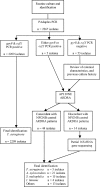Low rates of Pseudomonas aeruginosa misidentification in isolates from cystic fibrosis patients
- PMID: 19261796
- PMCID: PMC2681828
- DOI: 10.1128/JCM.00014-09
Low rates of Pseudomonas aeruginosa misidentification in isolates from cystic fibrosis patients
Abstract
Pseudomonas aeruginosa is an important cause of pulmonary infection in cystic fibrosis (CF). Its correct identification ensures effective patient management and infection control strategies. However, little is known about how often CF sputum isolates are falsely identified as P. aeruginosa. We used P. aeruginosa-specific duplex real-time PCR assays to determine if 2,267 P. aeruginosa sputum isolates from 561 CF patients were correctly identified by 17 Australian clinical microbiology laboratories. Misidentified isolates underwent further phenotypic tests, amplified rRNA gene restriction analysis, and partial 16S rRNA gene sequence analysis. Participating laboratories were surveyed on how they identified P. aeruginosa from CF sputum. Overall, 2,214 (97.7%) isolates from 531 (94.7%) CF patients were correctly identified as P. aeruginosa. Further testing with the API 20NE kit correctly identified only 34 (59%) of the misidentified isolates. Twelve (40%) patients had previously grown the misidentified species in their sputum. Achromobacter xylosoxidans (n = 21), Stenotrophomonas maltophilia (n = 15), and Inquilinus limosus (n = 4) were the species most commonly misidentified as P. aeruginosa. Overall, there were very low rates of P. aeruginosa misidentification among isolates from a broad cross section of Australian CF patients. Additional improvements are possible by undertaking a culture history review, noting colonial morphology, and performing stringent oxidase, DNase, and colistin susceptibility testing for all presumptive P. aeruginosa isolates. Isolates exhibiting atypical phenotypic features should be evaluated further by additional phenotypic or genotypic identification techniques.
Figures
Similar articles
-
[Use of 16S rRNA gene sequencing for identification of "Pseudomonas-like" isolates from sputum of patients with cystic fibrosis].Pathol Biol (Paris). 2005 Oct-Nov;53(8-9):500-2. doi: 10.1016/j.patbio.2005.06.004. Epub 2005 Aug 2. Pathol Biol (Paris). 2005. PMID: 16081224 French.
-
Denitrification by cystic fibrosis pathogens - Stenotrophomonas maltophilia is dormant in sputum.Int J Med Microbiol. 2015 Jan;305(1):1-10. doi: 10.1016/j.ijmm.2014.07.002. Epub 2014 Aug 10. Int J Med Microbiol. 2015. PMID: 25441256
-
PCR-based assay for differentiation of Pseudomonas aeruginosa from other Pseudomonas species recovered from cystic fibrosis patients.J Clin Microbiol. 2004 May;42(5):2074-9. doi: 10.1128/JCM.42.5.2074-2079.2004. J Clin Microbiol. 2004. PMID: 15131172 Free PMC article.
-
Pathophysiology and management of pulmonary infections in cystic fibrosis.Am J Respir Crit Care Med. 2003 Oct 15;168(8):918-51. doi: 10.1164/rccm.200304-505SO. Am J Respir Crit Care Med. 2003. PMID: 14555458 Review.
-
Current knowledge on Inquilinus limosus, a scarcely researched human pathogen.BMC Microbiol. 2024 Nov 13;24(1):474. doi: 10.1186/s12866-024-03617-6. BMC Microbiol. 2024. PMID: 39538164 Free PMC article. Review.
Cited by
-
Molecular identification of Pseudomonas aeruginosa recovered from cystic fibrosis patients.J Prev Med Hyg. 2014 Jun;55(2):50-3. J Prev Med Hyg. 2014. PMID: 25916020 Free PMC article.
-
Class C β-Lactamases: Molecular Characteristics.Clin Microbiol Rev. 2022 Sep 21;35(3):e0015021. doi: 10.1128/cmr.00150-21. Epub 2022 Apr 18. Clin Microbiol Rev. 2022. PMID: 35435729 Free PMC article. Review.
-
Impact of Achromobacter xylosoxidans isolation on the respiratory function of adult patients with cystic fibrosis.ERJ Open Res. 2019 Dec 8;5(4):00051-2019. doi: 10.1183/23120541.00051-2019. eCollection 2019 Oct. ERJ Open Res. 2019. PMID: 31832429 Free PMC article.
-
Antibiotic perturbation of mixed-strain Pseudomonas aeruginosa infection in patients with cystic fibrosis.BMC Pulm Med. 2017 Nov 2;17(1):138. doi: 10.1186/s12890-017-0482-7. BMC Pulm Med. 2017. PMID: 29096618 Free PMC article.
-
Biofilm on Toothbrushes of Children with Cystic Fibrosis: A Potential Source of Lung Re-Infection after Antibiotic Treatment?Materials (Basel). 2022 Mar 14;15(6):2139. doi: 10.3390/ma15062139. Materials (Basel). 2022. PMID: 35329591 Free PMC article.
References
-
- Anuj, S. N., D. M. Whiley, T. J. Kidd, S. C. Bell, C. E. Wainwright, M. D. Nissen, and T. P. Sloots. 2009. Identification of Pseudomonas aeruginosa by a duplex real-time polymerase chain reaction assay targeting the ecfX and the gyrB genes. Diagn. Microbiol. Infect. Dis. 63127-131. - PubMed
-
- Armstrong, D. S., G. M. Nixon, R. Carzino, A. Bigham, J. B. Carlin, R. M. Robins-Browne, and K. Grimwood. 2002. Detection of a widespread clone of Pseudomonas aeruginosa in a pediatric cystic fibrosis clinic. Am. J. Respir. Crit. Care Med. 166983-987. - PubMed
-
- Bosshard, P. P., R. Zbinden, S. Abels, B. Boddinghaus, M. Altwegg, and E. C. Bottger. 2006. 16S rRNA gene sequencing versus the API 20 NE system and the VITEK 2 ID-GNB card for identification of nonfermenting gram-negative bacteria in the clinical laboratory. J. Clin. Microbiol. 441359-1366. - PMC - PubMed
-
- Burdge, D. R., M. A. Noble, M. E. Campbell, V. L. Krell, and D. P. Speert. 1995. Xanthomonas maltophilia misidentified as Pseudomonas cepacia in cultures of sputum from patients with cystic fibrosis: a diagnostic pitfall with major clinical implications. Clin. Infect. Dis. 20445-448. - PubMed
Publication types
MeSH terms
Substances
LinkOut - more resources
Full Text Sources
Medical
Molecular Biology Databases


